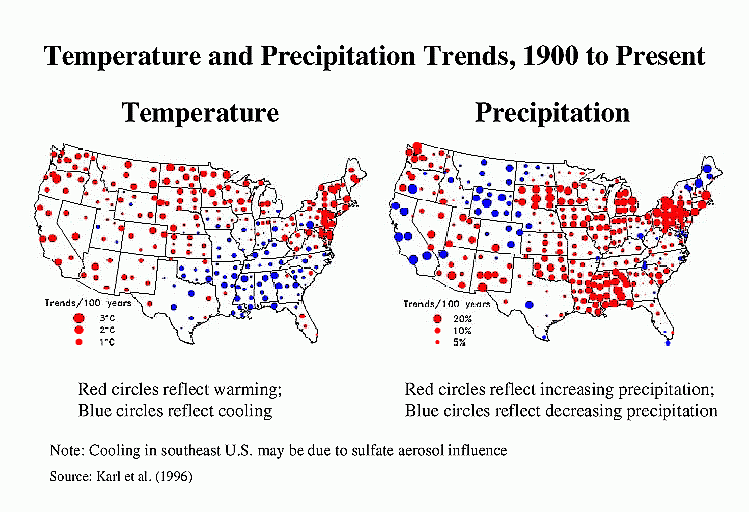![[Home]](../../icons/home.jpg)
![[Lectures]](../../icons/lectures.jpg)
![[Previous]](../../icons/previous.jpg)
![[Next]](../../icons/next.jpg)
Climate Change and Implications
Climate has changed in the past and will continue to change in the future. Climate change
is a part of Earth's history. The issue is whether or not humans are significantly
altering the natural progression of climate change, and if so, will these changes be
detrimental to life on Earth, including human life. The figure below shows measured changes
in temperature and precipitation over the United States from 1900-1996. The label
"Present" is about 8 years old. Although this figure is rather old, I present it here
because it shows that even though the global average surface temperature increased by about
0.5°C over this period, there is quite a bit of variation in the temperature and precipitation changes
at individual reporting stations.

Climate has changed during the past century. Below is a list
of some of the changes that have occurred. Note that these are observed changes,
so they have happened. However, we are unable to accurately determine how much influence
the increases in greenhouse gases have had on these changes.
- Global mean temperature has increased by about 1°F
- Minimum temperatures have increased more than maximum temperatures. Note
this is what would be expected if the increase in temperatures is due to a
stronger greenhouse effect (more noticeable effect at night rather than during
the day). However, this cannot be used as absolute proof that all of the
temperature increase is due to the additional greenhouse gases in the atmosphere.
- The frost-free season in much of the northern hemisphere middle and high
latitudes has lengthened.
- Global sea level has risen 4-10 inches
- Global precipitation has increased by about 1%
- Most of increase in middle and high latitude areas
- Slight decrease in subtropical regions (20-35)°Latitude
- (2-4)% increase in the frequency of heavy rain events in northern
hemisphere middle and high latitude regions.
- (10-15)% decrease in arctic sea ice in the spring and summer seasons
- Most continental and alpine glaciers have decreased in size
- Northern hemisphere snow cover has decreased by about 10%
- No conclusive change in severe weather events (such as tornadoes and hurricanes).
Some reasearch groups are claiming that hurricanes are becoming more
intense, while other groups dispute this claim.
- Limited observational evidence shows that some biological systems have already
been affected by climate change
- Lengthening of middle and high latitude growing seasons
- Poleward and altitudinal shifts of plant and animal ranges
- Earlier flowering of trees, emergence of insects, and egg-laying in birds.

Climate is expected to continue to change in the future. The following list
is based on climate model projected changes due to addition of greenhouse gases.
Because this list is based on climate model projections, these changes are by no means
certain, but they are the best estimates we can make at this time.
- Projected temperature increases of
(1.8-6.3°F) by 2010.
- Projected sea level rise of 20 inches by 2100 (range: 6-38
inches)
- Likely increase in precipitation intensity. More heavy rain events
and more severe droughts.
- Continued reduction in areal coverage of snow, glaciers, and sea ice.
- Continued changes in biological systems

Potential Impacts of Climate Change
- Human health, natural ecological systems, and
socioeconomic systems are all sensitive to both the magnitude
and the rate of climate change
- Many physical and ecological systems will be
simultaneously affected
- The ability of natural ecological systems to migrate
appears to be much slower than the predicted rate of climate
change
- Climate change can add to existing environmental
stresses
![[Potential Climate Change Impacts]](impacts.gif)
![[Home]](../../icons/home.jpg)
![[Lectures]](../../icons/lectures.jpg)
![[Previous]](../../icons/previous.jpg)
![[Next]](../../icons/next.jpg)



![[Potential Climate Change Impacts]](impacts.gif)





